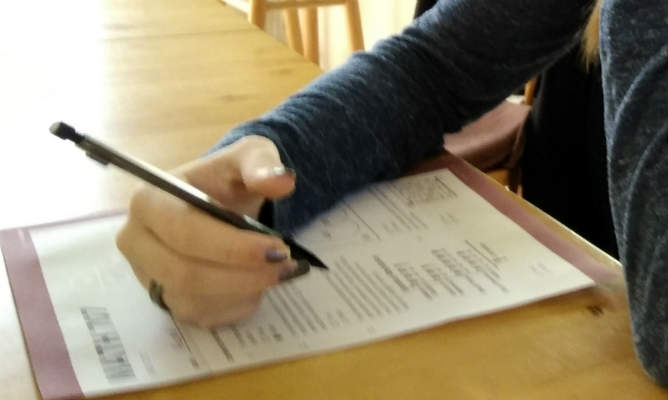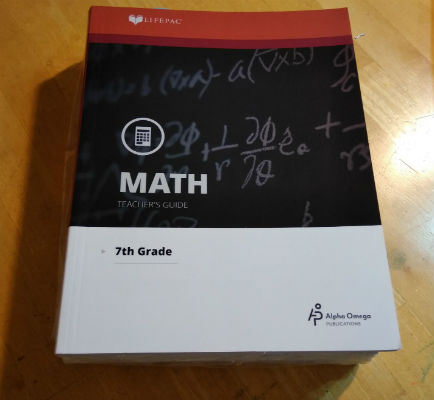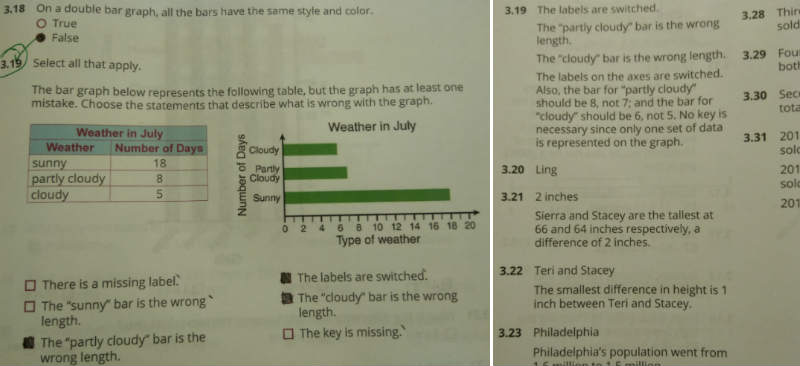Tackling Pre-Algebra with LifePacs

My 11-year-old twins and my 13-year old daughter have mastered basic math skills and are tackling pre-algebra. However, they have yet to like same math curriculum. It would simplify my life if they could all use the same one. This year I was on a quest to find the math curriculum all of them would love.
My 13-year old is my pickiest math student. She complains that Saxon is too hard and requires her to complete too many problems. She doesn’t like the online format of Khan Academy. Life of Fred has too much reading to suit her. No matter how awesome I think the curriculum is, she can always find its dark side. My twins are much more agreeable and have thrived in every math course.
Spring and summer found me haunting homeschool websites searching for the perfect pre-algebra program. Ideally, the curriculum would allow them to work independently, progressing at their own pace.
I finally settled on Alpha Omega’s LifePac curriculum. The explanations in the online sample pages seemed pretty easy to follow. There did not seem to be an overwhelming number of problems to solve. All the work could be written directly in the LifePac. This fresh approach might be just what we were looking for.
I downloaded the middle school placement tests and assigned each girl ten problems a day until we figured out exactly where they should begin. As I suspected, all three placed right at the beginning of seventh grade.
The seventh and eighth grade Math LifePacs work together to provide a complete Pre-Algebra/Pre-Geometry course. They review key math skills my girls have already learned and take them a step further to introduce algebraic concepts. After completing each of the ten workbooks, the student takes a final test. She must score 80% to pass. If she scores lower, she reviews the material and takes the alternate test provided in the Teacher’s Guide.

Challenges
We weren’t far out of the starting gate with LifePacs when problems arose. I was facing challenges while checking their work, and my 13-year-old was spending way too long on her math lessons.
Learning How to Use the Teacher’s Guide
LifePacs can be used independently but really require the parent to score them. I briefly considered letting the girls check their own work, but a quick peek at the solution key in the Teacher’s Guide changed my mind.
There is a learning curve for using the score key. The Teacher’s Guide first lists the correct answer(s) to each problem and then outlines the complete solution or explanation. Other curricula I have used place the final answer in bold print for quick identification and scoring. There is no such distinction in the LifePac Teacher’s Guide. In some multiple choice problems, where students are asked to choose all that apply, I must double-check to be sure which of the several lines represent answers my student was supposed to include and which ones are simply explanatory material. I much prefer Saxon’s solution guides which have final answers clearly visible!

Another challenge in using the Teacher’s Guide is locating the page which corresponds to my daughter’s work. The guide does not indicate what page the problems are on in the workbook. Several times I’ve started scoring a page and begun to mark my daughter’s work incorrect because I was looking at the wrong answers in the score key. Once, I even thought the score key for an entire page was incorrect and inserted the correct answers only to realize I had been looking at answers for the next LifePac page. I was extremely frustrated when I realized my mistake.
There have been a few times when I consulted with my older students about an answer, and we all agreed that the score key in the Teacher’s Guide was incorrect. In those cases, I have carefully crossed out the misprint and written in the correct answer.
Scoring all three girls’ math work took entirely too much effort. I purchased this curriculum to make my life simpler and less stressful, but it did not. My twins dropped LifePacs in favor of Life of Fred and Key to Algebra, which they could complete independently, scoring their own work. I focused on helping my 13-year-old succeed in the LifePacs.
Struggling with LifePac Workbooks
At first, I was puzzled when my daughter sought out her older brother’s help to complete her math lessons. I really thought she would be able to complete the work independently. Were the problems really that hard? Did the reading not completely explain the material?
The work was not actually that difficult…after she read the lesson. However, she was skipping directly to the problems and only referring back to the reading if she could not intuitively find a solution. Much of her daily work was incorrect because she had missed reading key information. Fortunately, she learned quickly from her mistakes and always managed to understand the material in time to pass the final test.
Unfortunately, there is little review of the concepts from previous LifePacs. Each one addresses a different set of math skills which seldom overlap with previous ones. I really hope my daughter is not forgetting the concepts from earlier workbooks.
Our Solution
Over time I realized that reading a lesson and working problems independently does not fit my daughter’s learning style, especially for pre-algebra. Math is tough for my extremely social 13-year-old. She much prefers seeking out help from an older sibling rather than scouring the pages of the LifePac to get the help she needs.
She had been spending hours in her room doing her schoolwork, often not even getting to math until after dinner time. I checked on her at regular intervals throughout the day to be sure she was making progress, and she usually was. But I suspect that she spent much more time petting the cat or rearranging furniture when I was not looking.
It was time for a compromise. I allowed my daughter to continue to work independently in her room all morning, but in the afternoon I required her to sit at the kitchen table and complete the remainder of her work with me by her side. Since she usually saves math for last, I am readily available to help her.
This strategy works very well. It allows me to observe her method of studying, encourage her to talk out her solution to each problem, and direct her back to the reading when necessary. I even let her be a little silly to lighten up a tough subject. Her latest LifePac covered statistics, which came much more easily to her, and I was a little disappointed she didn’t need my help as much. I am sure that she will face more challenging material soon though!
My daughter is nearly finished with the seventh grade LifePacs, and I am wondering where to go from here. She will be starting high school level work in her other subjects. Do I chance it with the eighth grade LifePacs? Should we try ACE PACEs again? Or should we try something completely new? Let me know what you think.